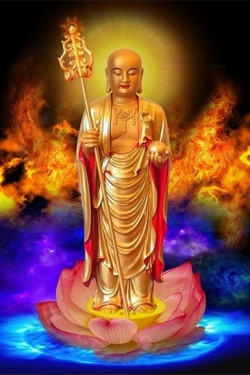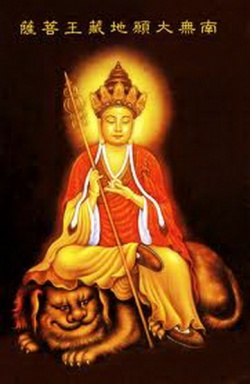The world in which gods and demons lived
Despite the prevalent opinion that all gods were inhabitants of heaven, their larger part lived on land, in water or underground. According to Indian and slavonic legends, gods-incomers (adityas/devas and Svarozhichi - svarozhichs) lived in the land (kingdom) of Indra/Svarog - Svarga/Blue Svarga, the capital of which the majestic city of gods Amaravati was. In spite of the fact that Old Indian written information sources point (indicate) to different location of Svarga and Amaravati - from the superior planets (Satjaloka, Maharloka, Svargaloka) to some area between the Earth and the Sun, of heaven or of the earth surface, in the Second and the Third books of the "Mahabharata" (Sabhaparva and Aranyakaparva) more than convincing arguments are given in favour of that Svarga, including Meru mount (Amaravati was on the top of it), Mandara and adjacent mounts with forests,
gardens, parks and orchards, was on the Earth (on land).
Here is how the land of Indra is described in the "Aranyakaparva" in B.L. Smirnov's translation from Sanscrit and author's translation from Russian:
At last the abode (dwelling place) of Shakra, Amaravati, I have seen.
the Sun there does not bake, neither heat, nor chill do not exhaust,
There on trees always flowers and fruits, (always)
Leaves turn green;
[There] various ponds, grown with the blue
Lotuses and lilies white, fragrant;
There winnows a fragrant breeze - vivifying, cool, pure;
There is possible to see many air chariots,
Flying by in heaven
The "Rigveda", the "Mahabharata", the "Bhagavata purana",Laws of Manu and other Old Indian texts, and also Old Iranian the "(Zend-Avesta" place Meru mount and accordingly Svarga in the far North:
On the North side, shining, there is mighty Meru Great Meru, the chaste (pure), good abode (dwelling place). Here set and again [over the Meru] rise Seven divine rishis led by Vasishtha (the "Mahabharata");
On Meru gods see the sun after its one-time rising over a period its path, equal to a half of its circulation round land. For gods and day and night - a year [[[human]]], again divided in two: day - the period of movement of the sun northward, night - the period of movement to the south (Laws of Manu).
The "Avesta" also give characteristic features of the polar disposition of Hara mount (Meru): That they consider by day, that is a year. there stars, moon, the sun can be seen once a year only rising and setting, and year seems only one day.
Judging by the fragments cited above, Svarga, "Paradise of Indra" or "Paradise of Svarog" was located near to the North pole and, perhaps, were by a part of the disappeared polar continent - Hyperborea. According to the descriptions given in the "Mahabharata", it was a mountainous country with mounts to the sky, the main of which was Mandara:
On the North side, shining, stands mighty Meru. The paradise of great god Indra placed on its top. From these mounts the great rivers fall. At the bottom of Meru -
adobe of gods , Milk ocean is, and before the great mounts Meru sandy sea is stretched out.
Svarga can be compared with Jambudvipa described by Shukadeva Gosvami in the "Bhagavata {{Wiki|purana]]" . If we clean it from poetic embellishments (such, as trees up to heaven, lakes of honey and milk) it come to the following.
In Jambudvipa there is Sumeru mount. Sumeru is environed by four other mounts: Mandara, Merumandara, Suparshva and Kumuda. On these four mounts mango trees, pink apples trees, kadamba trees and banyan trees grow. Besides, there are a lot of lakes with pure water. There are also gardens, the names of which are Nandana, Chitraratha, Vaibhradzhaka and Sarvatobhadra. Sumeru is surrounded by twenty mountain chains, including Kuranga, Kurara, Kusumbha, Vaikanka and Trikuta. To the East from Sumeru Dzhathara and Devakuta mounts, to the West from Sumeru - Pavana and Pariyatra, to the South - Kailasa and Karavira, and to the North - Trishringa and Makara. On the top of Sumeru there is Brahmapuri, residence of Lord Brahma. Round Brahmapuri are cities of tsar Indra and seven other demigods. Each of these cities is in four times less than Brahmapuri.
Comparing different descriptions of Meru-Svarga-Jambudvipa among themselves, somebody pays attention at once to their obvious differences. On the one hand, this country was situated near to the North pole in the area of gloom and snow, where stars rotate, Moon and the Sun. On the other hand, there was never cold on it, evergreen trees and flowers grew, larger part of which could grow only in warm tropical climat.
It can be related as with different time of compiling of legends, so with repeated application in the "Mahabharata", the "Ramayana", the "Bhagavata {{Wiki|purana]]" and other Old Indian texts of additions and adjustments (improvements). And, most likely, that and other together.
In my opinion, the fragments given above describe different time - when Svarga represented the country with warm tropical climat and gods-incomers (adityas, Svarozhichi -svarozhichs, etc.) lived in it, and when the country, fertile before, had turned out in the area near the North pole (or to the contrary, the North pole moved to it) and had been locked by ice (has been icebound). Judging by the having data, it had happened rather recently (about 12,5 thousand years ago), and the most possible reason of it was the global catastrophe accompanied by a shift of the Earth's axis.
But patience! I will tell to you about it in my following work. And now I will continue the narration about where other gods lived.
According to the Old Indian Veda, epos and puranas, earthly gods of second generation - Shiva and Kubera together with their suite of yakshas, rakshasas, pishachas and nirritis inhabited neighbourhoods of Kailas mount in the Himalayas . Divine architect Vishvakarman had built there for Kubera capital Alaka (Alaca) with perfect gardens, parks and orchards.
Kubera earlier lived in Lanka (Lanca) city, but his brother Ravana had driven him away from there. He had made Lanka (Lanca) by the capital of the powerful empire of rakshasas. According one data , Lanka (Lanca) was on Shri Lanka island. According to the translator of the "Bhagavata {{Wiki|purana]]" Shrila Prabhupada, it was located on the territory of the modern Brazil.
Powerful marine demons nivatacavachs, apparently, lived in the opposite from Svarga part of the terrestrial globe (remote from it, approximately, as the modern Antarctica are remote from Greenland). Possible evidence of that is described in the "Aranyakaparva" prolonged travelling of Ardzhuna and Matali on a flying chariot over immense ocean from Svarga to the city of nivatacavachs.
Belonging to demons daityas and danavas and fully or partly corresponding to them Old Iranian devas, Old Slavic Svarozhichi-svarozhichs (under leadership of Dennitsa) and, perhaps, Dyievichi-dyievichs, Old Scandinavian vanes and aces, Ancient Greek titans and, perhaps, Olympians and others related to them gods, demigods and demons populated the major portion of the surface of our planet. At first they divided it with aboriginal inhabitants of the Earth - viyevichs, nagas, rakshasas, nirritis, fomorians, rudras and other "people", but then, in the process of extermination of the last, became its absolute masters (together with the opposed party - adityas and their human offsets).

